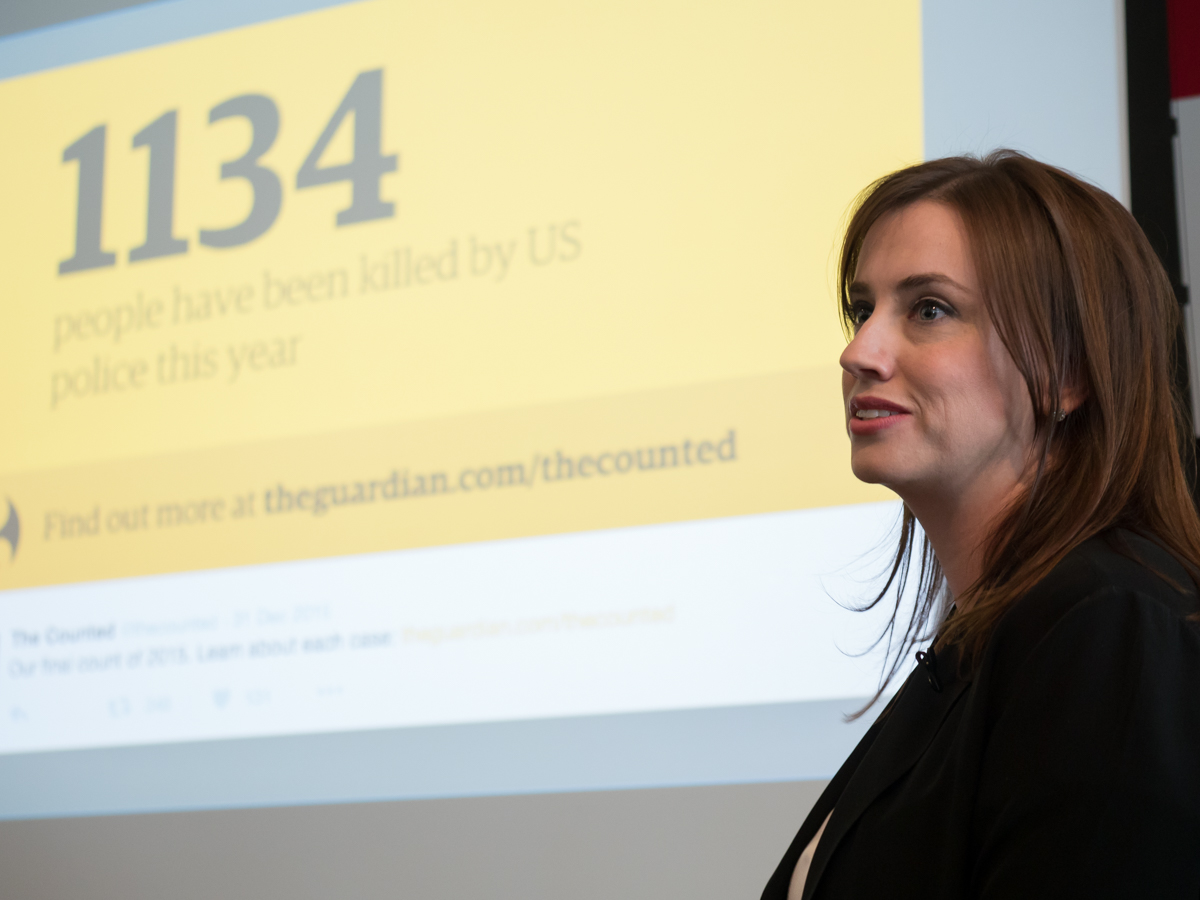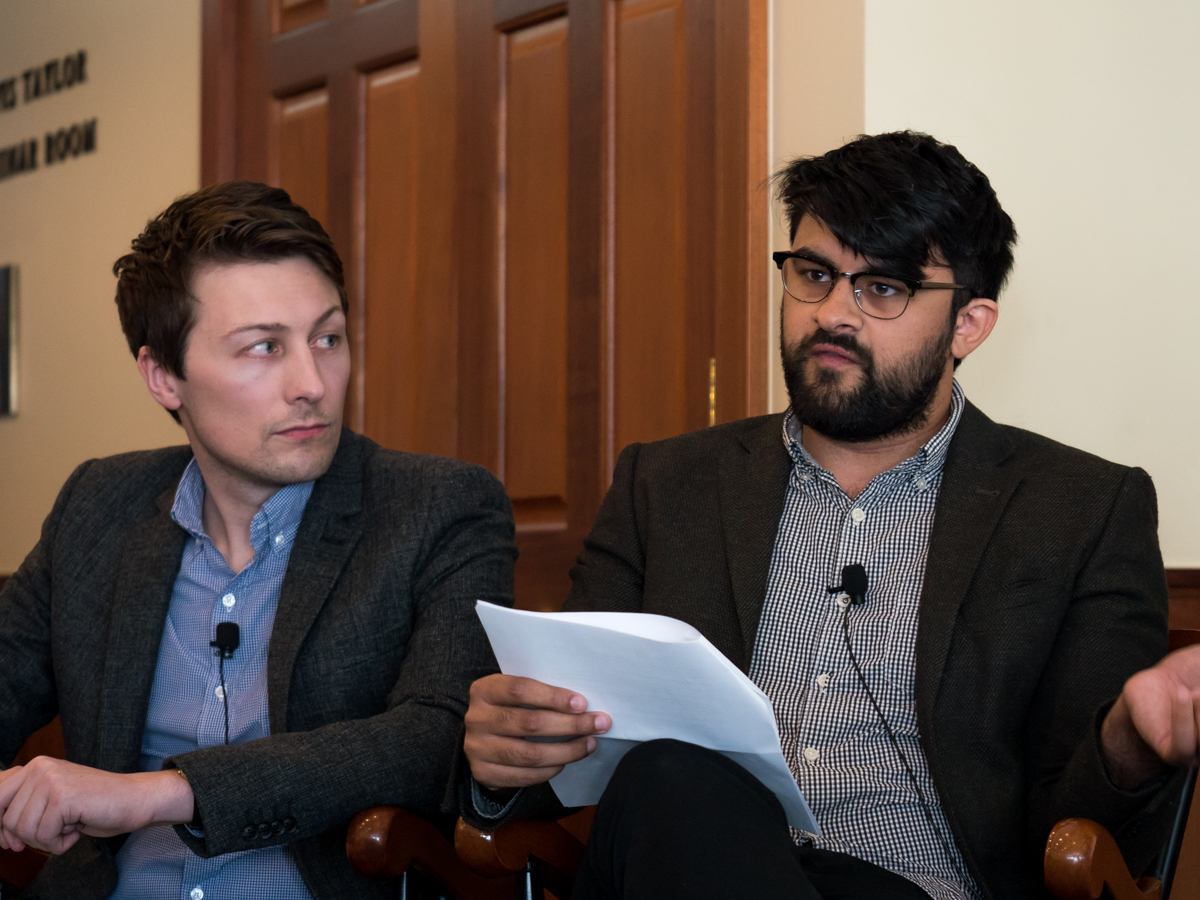
Guardian US editor Lee Glendinning says the newspaper brings a fresh perspective to under-covered stories
The Guardian US, launched in 2011, has posted impressive gains in traffic and revenue over the past year while a signature project, The Counted, did for 2015 what no media outlet or federal agency had ever done: counted and chronicled every killing by police throughout the US. (The total for the year stands at 1,139.)
The Guardian US operation is no behemoth. There is a staff of 50 in New York, Washington, D.C., and San Francisco. During a talk at the Nieman Foundation, Lee Glendinning, editor of The Guardian US, said, “What we’ve tried to do in America is really focus on issues that can make us a distinct voice in this industry’s landscape, and look at things that are under-covered by the national press.”
The strategy has been a success. Revenue for The Guardian US is up by 66 percent compared to this quarter last year. In November, The Guardian had 34.5 million unique users in the US, an increase of nearly 55 percent over that month in 2014, according to comScore.
The Counted, Glendinning said, “began because we were shocked that the federal government kept no comprehensive record of the amount of people killed by police in the US. … We believed that this kind of accounting was a prerequisite for any kind of real conversation to take place about what was happening with police killings in America.”
Glendinning was invited to talk about the creation of The Counted, what its impact has been, and what’s the value of such data-driven projects to readers as well as to the bottom line of The Guardian US. She was joined by senior reporters Jon Swaine and Oliver Laughland who worked on The Counted. Edited excerpts:
What about the structure of The Guardian US newsroom makes it possible to do massive projects like The Counted?
Glendinning: What’s been remarkable about The Counted is that it’s been one of the most collaborative projects I’ve ever worked on. The audience, the interactive team, the reporting team, the editors, the video, photography, and production teams were all involved. From the very beginning, outside the conception point, we were together in brainstorming meetings with members of all of those teams, so that none of those elements were an afterthought. The crowdsourcing was at the heart of the project.
Laughland: Different stages of the projects required different types of collaboration. Jon and I and Jamiles Lartey were the core reporting team. Once we conceived where we were going with the story, we would sit down with the interactive team and ask them how they could help us tell the story in a way that was using their expertise and using the data, manipulating it to be reader friendly.
How did the crowdsourcing work?
Glendinning: We said from the beginning, “You, the public, need to help us build this database. You need to tell us when you see things that are going on. We will check them. We will verify them. We will look into them.” Within the first month of launching The Counted, we had a community of 20,000 people who were contributing to the tip box, sending in information that the reporting team could then verify.
Swaine: The proportion is hearteningly high, from good tips to bad. I can only think of two [bad tips] in the entire project. Most are just very solid. There seems to be a community who was ready for involvement in that task.
You made the database available to the public. Is that something that The Guardian does as a matter of course?
Glendinning: Open journalism is very much a fundamental principle of The Guardian. We believe that the act of publishing is not the end of the story. It’s the beginning of it.
Open journalism is very much a fundamental principle of The Guardian
Laughland: The guiding principle behind The Guardian’s “Datablog” is that everything that they publish is also downloadable.
Swaine: If you go on the “About” page on The Counted, you can download a spreadsheet that basically gives you the majority of the data. It was interesting, as an outsider coming from a place [The U.K.’s Daily Telegraph newspaper] that didn’t have that mentality, when the interactive team said, “We’ll obviously make this downloadable.” I have to admit, I wondered: Is that the right thing to do? They were proven right.
There is a team from Harvard School of Public Health that used the data for research. It’s been downloaded by a team at Michigan State looking at the race and ethnicity of police officers. All these journalistic and academic projects have been able to be born from it.

Jon Swaine, left, and Oliver Laughland were two of the reporters who had to verify tips submitted by the public for The Counted
There’s an obvious journalistic public interest in doing the stories. How would you characterize the impact of the stories and the benefit to Guardian US?
Glendinning: The benefit is huge. As for the impact, first of all look at the pilot programs that are going on within the Department of Justice and the FBI to emulate the system that we have built. Secondly, to be able to say that there have been at least five people that we have named who’ve been killed by police in the United States that no one would necessarily have known about. In addition, at least one of our stories, the case of William Chapman, an 18-year-old black man who was killed by a police officer in Virginia, has led to an indictment. That huge dataset has led us to stories such as the high rate of killings by police in Kern County, California; the extent to which Tasers are being used and the 49 deaths caused by them in 2015; and the frequency of people in moving vehicles being shot by police. A million people in America have accessed this database, 1.5 million people around the world. It is regularly one of the most-read things on the site, despite how grim the nature of the information within it is.
When we talk about a point of distinction in the US market, when we talk about having fresh eyes on these stories, by the pure act of us counting every day and maintaining this database and telling the stories out of that, it is a really powerful thing for us to do in America and to be telling that story to the world.
Speaking of fresh eyes, the newsroom of The Guardian US is 59 percent women. What implications does that have for your newsroom and the stories that get covered?
Glendinning: The Guardian has always been tremendous on female leadership. Our editor in chief is Katharine Viner and we have women in very senior positions around the world. Diversity is such an important part of what we’re doing in America and in The Guardian, globally. We can always be better and we strive to do that daily. This year, on our opinion site, I think 35 percent of our bylines were people of color.
Swaine: Sometimes as a male journalist you don’t realize until you’re in a properly balanced work environment how much has been excluded until then. The types of ideas and types of experiences that people bring to bear in the newsroom, the conversations in the morning news conference. It stands to reason that if you’ve got a table at which only men are sitting, there are certain stories that they’re going to have no idea about. The West Coast office recently did a big story about the groundswell of opinion against the tampon tax. A male-dominated newsroom probably wouldn’t have realized the basic importance of that story.
Glendinning: As far as gender equality in our coverage, it’s something that I’ve outlined as really important to us. It’s an area that is undercovered. The erosion of reproductive rights across America or in certain states of America is something that we need to be focused on and reporting out and telling these stories and being unafraid of telling these stories. Equally, when things play out within Republican debates that are anti-women, I think it’s a really important area for us.

